The Mediterranean diet is renowned for its focus on healthy fats, lean proteins, and an abundance of fresh fruits and vegetables, woven together with the flavorful threads of various cuisines from countries along the Mediterranean Sea. For those with celiac disease or gluten sensitivity, adapting this diet to be gluten-free is not only feasible but can also be quite enjoyable, especially when incorporating a rich variety of fish and seafood. These marine proteins are naturally gluten-free and provide a wide array of nutrients, aligning well with the diet’s emphasis on heart health and overall well-being.
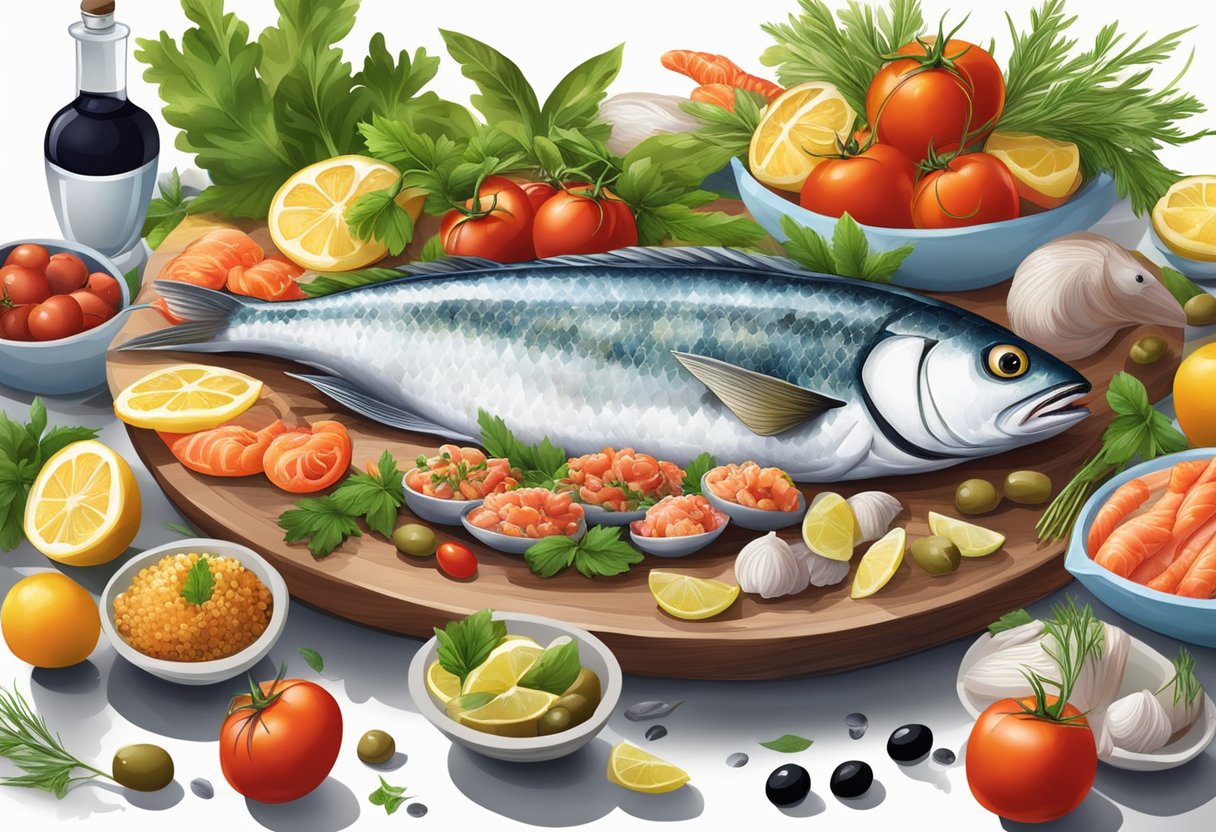
Creating a satisfying and nutritionally complete gluten-free Mediterranean diet involves careful selection of ingredients and thoughtful substitutions to avoid gluten-containing grains. Fresh seafood, from cod to shellfish, can be seasoned with herbs like oregano and thyme, and accompanied by roasted cherry tomatoes, olives, and capers to maintain the essence of Mediterranean cuisine. Trust in traditional cooking techniques, understanding the foundation of the diet, and embracing the natural flavors of the region results in delicious dishes that support a healthy lifestyle.
Key Takeaways
- A gluten-free Mediterranean diet includes a variety of fish and seafood, essential for nutrient diversity and adherence to the diet’s principles.
- Selecting gluten-free ingredients and making smart substitutions are key to upholding the Mediterranean diet’s gluten-free integrity.
- The diet supports overall health, particularly for individuals with celiac disease or gluten sensitivities, without compromising on flavor or enjoyment.
Table of Contents
Understanding the Gluten-Free Mediterranean Diet
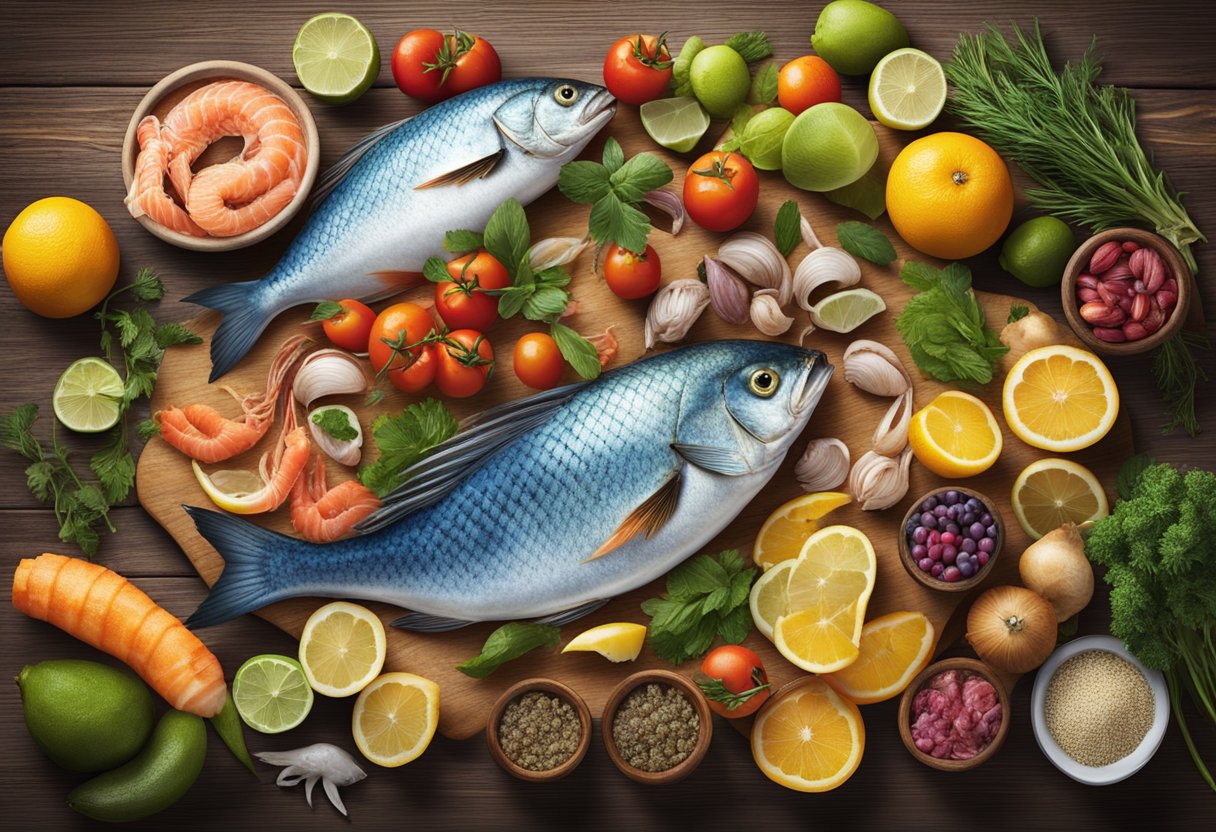
The integration of the gluten-free lifestyle into the Mediterranean diet creates an approach that combines traditional, nutrient-rich foods with the requirements necessary for those with celiac disease or gluten intolerance.
Core Principles
The Mediterranean diet emphasizes a high intake of vegetables, fruits, whole grains, and legumes. Healthy fats, particularly from sources like extra virgin olive oil, are central to this diet’s philosophy. When adapting to a gluten-free version, essential grains such as barley, rye, and wheat are replaced with gluten-free alternatives. Seafood and poultry are consumed in moderation, with a distinctly lower consumption of red meat and sweets.
Health Benefits
Embracing a gluten-free Mediterranean diet supports heart health, may improve blood sugar levels, and is linked to a decreased risk of chronic diseases. For those with celiac disease, it maintains the diet’s integrity without compromising on gluten-free needs. The balance of nutrient-rich, gluten-free foods is crucial for promoting overall wellness and maintaining a healthy weight.
Gluten-Free Mediterranean Diet Meal Plan
In a meal plan tailored to this diet, breakfast might include a bowl of gluten-free oatmeal with fresh fruit, while lunch could comprise of a quinoa salad with vegetables and grilled fish. Dinners focus on baked or grilled seafood, accompanied by a variety of vegetables seasoned with herbs. Snacks often consist of nuts, seeds, or fruit, ensuring a balanced diet throughout the day. A weekly meal plan ensures that individuals get a varied intake of foods while respecting both Mediterranean and gluten-free dietary guidelines.
Essential Ingredients and Substitutions
Incorporating key ingredients and making thoughtful substitutions is crucial for maintaining the integrity of a gluten-free Mediterranean diet while ensuring nutritional needs are met.

Olive Oil and Healthy Fats
Olive oil, particularly extra virgin olive oil, is a staple in the Mediterranean diet, cherished for its flavor and health benefits. It’s used in dressings, for sautéing, and as a dip. For those managing celiac disease or gluten sensitivities,flaxseed oil and avocado oil can also serve as healthful fats in the diet.
Gluten-Free Grains
Grains are central to the Mediterranean diet, but must be gluten-free for those with celiac disease. Quinoa, oats (certified gluten-free), and rice are nutritionally rich substitutions. They can be enjoyed in salads, as side dishes, or used in recipes to thicken soups and stews.
Fresh Vegetables and Fruits
Vegetables and fruits are pillars of this diet, providing a variety of nutrients and antioxidants. Staples include leafy greens, cruciferous vegetables like broccoli, and fruits such as berries and citrus fruits. These are integral, either raw or cooked, in salads, sides, and as snack options.
Quality Protein Sources
When it comes to protein sources, fish and seafood are central to the Mediterranean approach, offering omega-3 fatty acids critical for heart health. Alternatives such as legumes, including chickpeas and beans, are excellent gluten-free options that also contribute protein and fiber to the diet.
Gluten-Free Mediterranean Recipes
The gluten-free Mediterranean diet is a harmonious blend of flavors, offering a variety of fish and seafood dishes that cater to all meal times. These recipes are designed to be both delicious and simple to prepare, with an emphasis on fresh ingredients and vibrant Mediterranean spices.
Breakfast Options
For a gluten-free start to the morning, one can enjoy a light yet nourishing dish such as Mediterranean Shrimp and Zucchini Scramble. This breakfast combines succulent shrimp, fresh zucchini, and a sprinkle of herbs, offering a flavorful twist on traditional scrambled eggs.
- Ingredients: Shrimp, Zucchini, Eggs, Garlic, Parsley
- Key Spices: Salt, Pepper, Paprika
Another excellent choice is the Greek Yogurt with Lemon and Tomatoes, providing a tangy and refreshing wake-up for your taste buds.
- Ingredients: Greek Yogurt, Lemon Juice, Cherry Tomatoes, Kalamata Olives
Lunch Selections
For lunch, gluten-free options abound with dishes like Grilled Salmon with Tzatziki. This dish balances the richness of salmon with the coolness of tzatziki sauce.
- Ingredients: Salmon, Greek Yogurt, Cucumbers, Garlic, Lemon Juice
- Key Spices: Salt, Pepper, Dill
Alternatively, the Mediterranean Tuna and Couscous Salad (using gluten-free couscous) presents a fulfilling yet easy-to-make meal that is perfect for packing as a work lunch or enjoying at home.
- Ingredients: Tuna, Gluten-Free Couscous, Tomatoes, Olives, Lemon Juice
- Key Spices: Salt, Olive Oil
Dinner Delights
Come dinner time, dishes such as Baked Cod with a Lemon Garlic Sauce bring the essence of the Mediterranean to your dining table.
- Ingredients: Cod, Lemon, Garlic, Olive Oil
- Sauce: Lemon Juice, Garlic, Olive Oil, Parsley
An alternative is the Sheet-Pan Shrimp with Roasted Vegetables, which offers an easy and healthful one-pan meal.
- Ingredients: Shrimp, Bell Peppers, Tomatoes, Zucchini
- Key Spices: Paprika, Garlic, Salt, Pepper
Simple Sides and Salads
To pair with any meal, the classic Greek Salad is naturally gluten-free and packed with the robust flavors of the Mediterranean.
- Ingredients: Tomatoes, Cucumbers, Onions, Kalamata Olives, Feta Cheese
- Dressing: Olive Oil, Lemon Juice, Oregano
In addition, Roasted Broccoli with Lemon and Garlic serves as a tasty side, rich in both nutrients and flavor.
- Ingredients: Broccoli, Lemon Zest, Garlic
- Key Spices: Salt, Pepper
Safe Food Handling and Preparation Techniques

In a gluten-free Mediterranean diet, the proper handling and preparation of fish and seafood are crucial to maintaining both the integrity of a gluten-free diet and the freshness typical of Mediterranean cuisine.
Selecting Fresh Fish and Seafood
When choosing fish and seafood, it’s essential they are as fresh as possible. Look for clear, bright eyes and firm flesh; their scent should remind one of the ocean, not overly fishy. Mediterranean dishes often call for whole foods, and fresh seafood falls perfectly in line with this concept.
- Eyes: Should be clear and slightly bulging.
- Skin: Must gleam with metallic brightness.
- Flesh: Needs to be firm to the touch and bounce back when pressed.
- Smell: A clean scent like saltwater is a sign of freshness.
Avoiding Cross-Contamination
To keep a gluten-free kitchen, preventing cross-contamination is imperative. Use separate cutting boards, utensils, and cookware exclusively for gluten-free cooking.
Here’s how to avoid cross-contamination:
- Separate cookware: Use dedicated gluten-free pots, pans, and utensils.
- Clean surfaces: Thoroughly clean counters before preparing gluten-free dishes.
- Storage: Store gluten-free items separately to prevent accidental gluten exposure.
Cooking Methods and Best Practices
The Mediterranean diet is renowned for its healthy cooking methods. Grilling, baking, and sautéing with extra virgin olive oil not only enhance the flavor of fish and seafood but also preserve their nutritional value.
- Grilling: Provides a smoky flavor and allows excess fat to drip away.
- Baking: Gentle cooking method that maintains moisture and nutrients.
- Sautéing: Quick method using olive oil or garlic cloves to add a punch of flavor.
Extra Tips:
- Use fresh herbs to enhance the natural flavors of fish and seafood.
- Extra virgin olive oil is preferred for its health benefits and robust taste.
Eating Out and Managing your Diet

When adhering to a gluten-free Mediterranean diet, individuals must approach restaurant dining with a strategy that aligns with their health objectives, while ensuring the enjoyment of Mediterranean flavors.
Navigating Restaurants and Menus
When one is dining out, they should first identify restaurants that offer Mediterranean dishes with a focus on fresh fish and seafood, which are staples of this diet. They can usually find a variety of gluten-free options by looking for keywords like “grilled,” “roasted,” or “steamed” next to seafood entries. Patrons should not hesitate to ask questions about menu items to ensure that dishes are free from gluten-containing ingredients.
Tips for Ordering Gluten-Free Options
To maintain a healthy diet while eating out, individuals should:
- Start with a salad dressed in olive oil and lemon juice to stay true to the Mediterranean diet and avoid gluten-containing dressings.
- Opt for main dishes that include lean proteins like fish, which should be prepared without breading or marinades containing gluten.
- Verify that side dishes like rice or quinoa are prepared without any gluten-containing broths or sauces.
For a diet-conscious experience in a restaurant, individuals should communicate clearly with the wait staff about their dietary restrictions to ensure a safe and enjoyable meal.
Lifestyle Considerations and Support
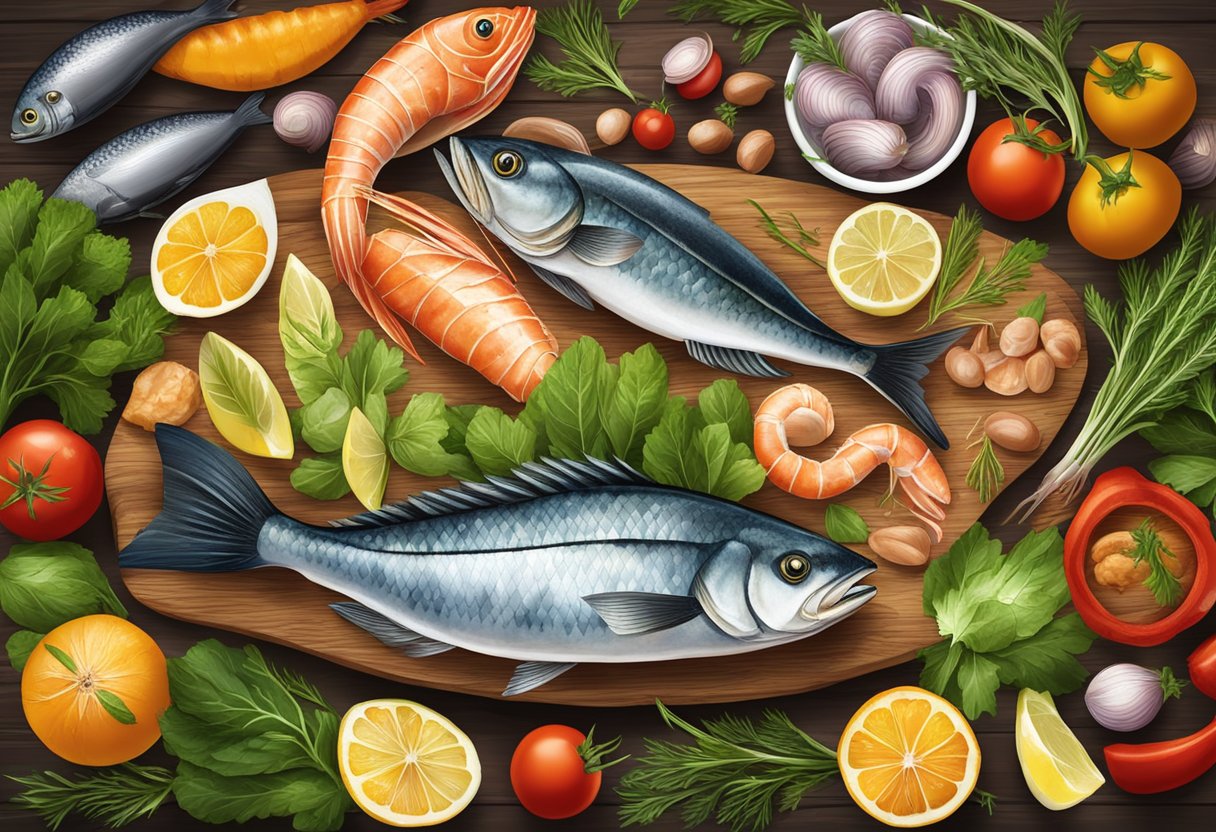
When adopting a gluten-free Mediterranean diet, individuals should consider how this diet aligns with their overall lifestyle and the availability of support systems that can assist in maintaining this healthy dietary pattern.
Integrating Diet with Lifestyle
A Mediterranean diet is traditionally rich in fish and seafood, which are important sources of omega-3 fatty acids and lean protein. These nutrients contribute to cardiovascular health and general well-being. In a gluten-free Mediterranean diet, individuals must also take care to avoid gluten, which is crucial for those with celiac disease. They are encouraged to enjoy fish and seafood twice a week, and to find gluten-free whole grains and pastas as alternatives to the commonly found wheat-based products. Integrating the diet into one’s lifestyle requires mindfulness about food choices, especially when dining out or shopping for food.
- Planning: Weekly meal planning to incorporate a variety of fish and seafood.
- Shopping: Selecting gluten-free products and fresh seafood at grocery stores or local markets.
- Cooking: Preparing meals at home that feature fish and ingredients common in the Mediterranean palette, ensuring they are free of gluten.
Support Groups and Resources
Support groups and resources are valuable for individuals who are new to the gluten-free Mediterranean diet or looking for ongoing support. They offer a sense of community and shared experience that can make managing the diet’s requirements less daunting.
- Local and Online Support Groups: Engaging with others who follow a gluten-free or Mediterranean lifestyle for practical advice and emotional support.
- Educational Resources: Utilizing reliable websites like the Celiac Disease Foundation or Beth Israel Deaconess Medical Center’s Celiac Center for meal plans and dietary guidance specifically designed for a gluten-free Mediterranean diet.
Engaging with these networks and resources helps individuals adhere to a healthy lifestyle and navigate the challenges of combining a gluten-free and Mediterranean diet successfully.
Nutritional Information and Guidelines
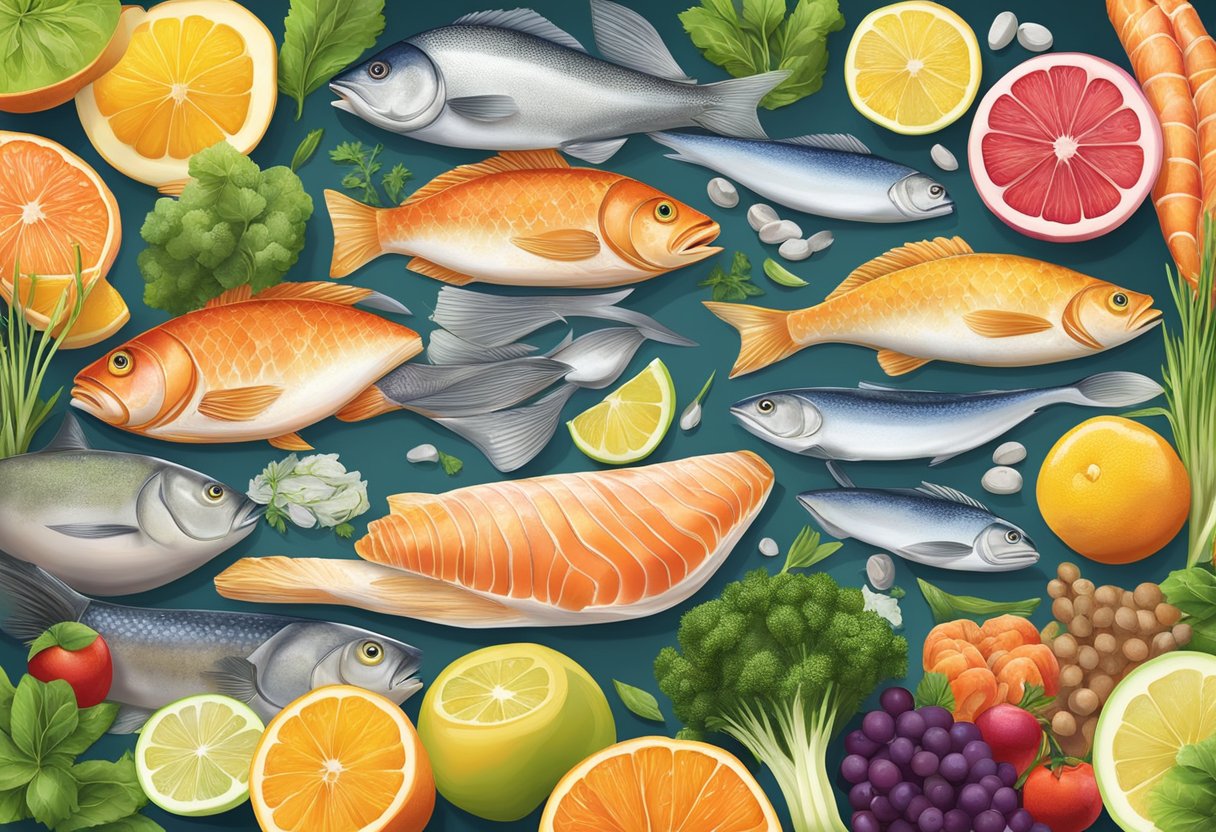
Adopting a gluten-free Mediterranean diet involves incorporating a wide array of foods that provide both macronutrients and micronutrients. Fish, rich in omega-3 fatty acids, is complemented by a diverse intake of vegetables, nuts, legumes, and whole grains, ensuring a balanced and nutritious dietary approach.
Balancing Macronutrients
On the gluten-free Mediterranean diet, individuals should emphasize a balance between proteins, carbohydrates, and fats. Fish serves as an excellent protein source, supporting muscle health and immune function. Seafood, consumed twice a week as recommended by sources like Beth Israel Deaconess Medical Center, should be a staple, ideally paired with gluten-free whole grains like quinoa or brown rice. A moderate amount of healthy fats is also integral, with options such as olive oil and avocados.
Understanding Micronutrients
Micronutrients, including vitamins and minerals, are vital to maintaining health on a gluten-free Mediterranean diet. Fish provides vitamins D and B12, important for bone health and energy metabolism, respectively. Vegetables and nuts contribute vitamins A, E, and C, along with minerals like iron and magnesium, essential for various bodily functions. Legumes, a gluten-free plant protein, are abundant in fiber, magnesium, and iron.
Dietary Tips for Optimal Health
When striving for optimal health on a Mediterranean diet, it is crucial to select a variety of colorful vegetables each day, ensuring a comprehensive nutrient profile. Legumes should be included regularly for their fiber and protein content, while nuts offer a healthy snack with essential fats. Integrating dairy in moderation provides calcium for bone health. Lastly, one must be vigilant about reading labels to maintain a strict gluten-free diet, avoiding cross-contamination which can be particularly challenging at social gatherings and restaurants.
Adapting Family and Cultural Dishes
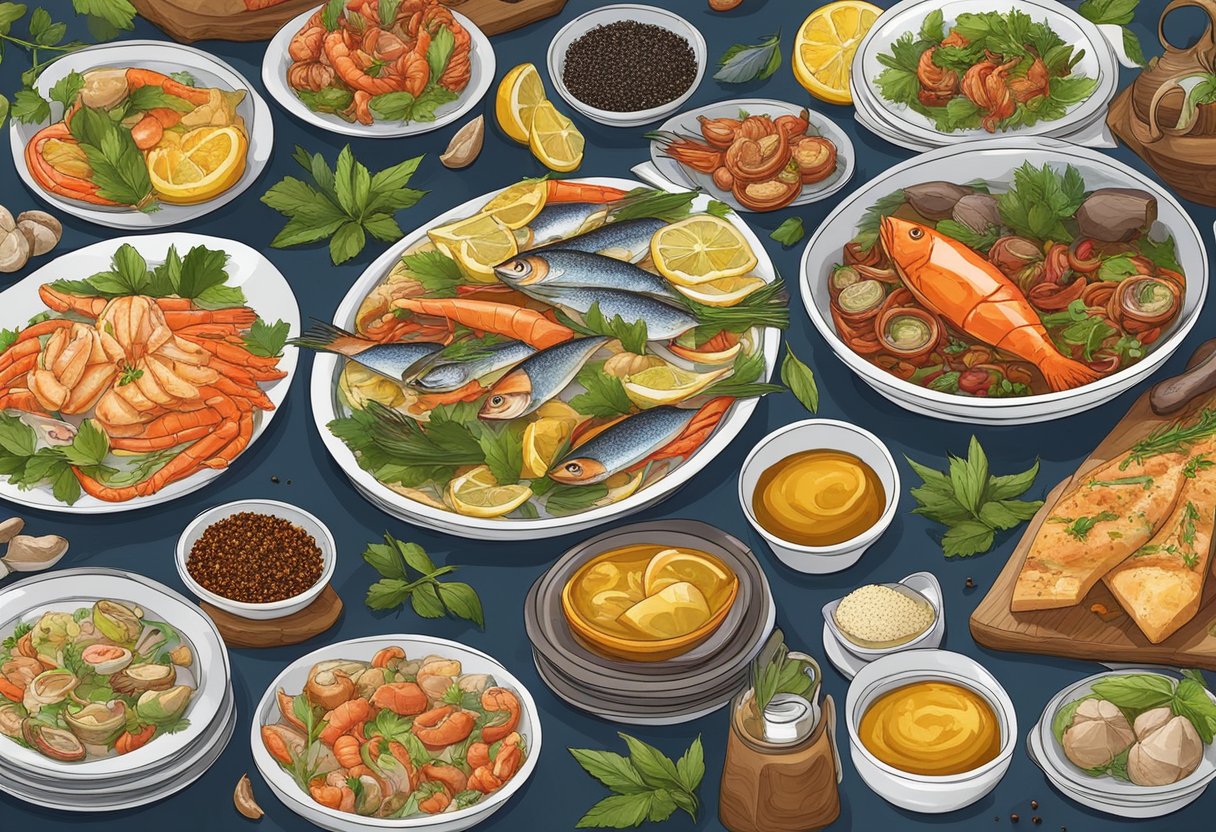
Adapting family and cultural dishes to align with a gluten-free Mediterranean diet involves thoughtful substitutions and a focus on the rich variety of ingredients that the diet naturally encompasses. It ensures that individuals with gluten sensitivity can still enjoy the flavorful heritage of Mediterranean cuisine.
Modify Traditional Recipes
When modifying traditional recipes, replacing ingredients that contain gluten is essential. For example, in Italian cooking, one might substitute regular pasta with rice or legume-based pastas when making a classic seafood spaghetti. Ingredients such as olive oil, vegetables, and fish remain central to the dish, preserving its Mediterranean essence while ensuring it is gluten-free.
- Replace: Traditional pasta ➜ Gluten-free pasta (brown rice, quinoa, or lentil pasta)
- Maintain: Olive oil, garlic, tomatoes, and fresh herbs
Gluten-Free Alternatives for Cultural Foods
In seeking gluten-free alternatives for cultural foods, one should not overlook dishes that are naturally gluten-free. Many Mediterranean dishes already focus on healthy proteins like fish and an abundance of vegetables, which don’t require any modifications. For instance, a Greek salad with legumes and grilled fish is intrinsically gluten-free.
- Utilize: Fresh fish, olive oil, herbs
- Opt for: Grilled or baked fish with a side of roasted vegetables drizzled with olive oil
Incorporating gluten-free grains such as rice into cultural dishes also complements the existing palette of Mediterranean flavors. A paella dish that hails from Spain, for example, can be easily adapted to fit a gluten-free diet without losing its authenticity.
By focusing on these substitutions and alternatives, family and traditional Mediterranean recipes can be successfully adapted for a gluten-free lifestyle, allowing for both cultural appreciation and dietary compliance.
Special Topics in Gluten-Free Mediterranean Cuisine
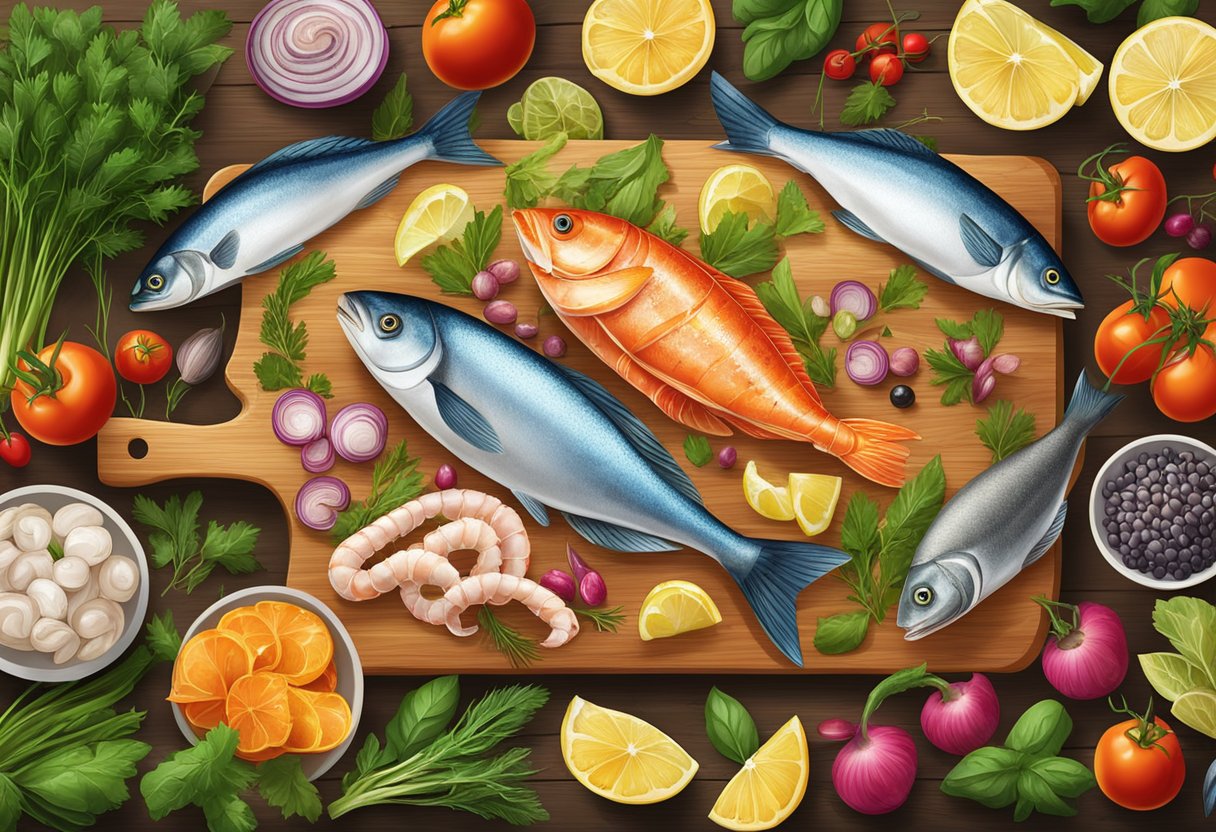
Within the scope of a gluten-free Mediterranean diet, seafood presents an exceptional opportunity to align with both health goals and culinary traditions. Explicit attention to seasonal and local produce enhances the freshness and nutritional value of dishes, while sustainable choices ensure ecological responsibility.
Seasonal Eating and Locality
Embracing seasonality is quintessential in the Mediterranean culinary ethos. The diet emphasizes the inclusion of fish and vegetables at the peak of their freshness, which not only provides optimal flavor but also maximizes the nutritional content. Consumers preferring a gluten-free lifestyle can relish in a variety of seafood that comes from the Mediterranean Sea, aligning their meals with the rhythm of nature. For example, sardines and anchovies are often most plentiful in the late spring and summer months.
- Spring: seabream, anchovies
- Summer: sardines, mackerel
- Fall: swordfish, sea bass
- Winter: hake, cod
Selecting fish and produce that are local to the region not only supports the local economy but also ensures a lower carbon footprint due to reduced transport distances.
Sustainability and Eco-Friendly Choices
The concept of sustainability is deeply ingrained in Mediterranean practices. Choices of fish and seafood in the diet are commonly guided by eco-friendly principles. It’s emphasized that one should opt for species that are not overfished or those farmed with responsible practices. For instance:
- Recommended: Farmed mussels, wild-caught small pelagic fish
- Avoid: Overfished species like some tunas, orange roughy
When it comes to vegetables, the Mediterranean diet favors organic and locally-sourced options, reducing the reliance on pesticides and harmful farming practices that can impact both health and the environment. This alignment with healthy, gluten-free, and sustainable principles showcases a deep respect for both personal well-being and ecological balance.
Product Reviews and Recommendations
When considering a gluten-free Mediterranean diet, selecting products that align with both dietary needs is key. This section delves into reviews of gluten-free options and identifies essential Mediterranean diet products.
Gluten-Free Product Reviews
- Frozen Gluten-Free Fish Fillets: A convenient option for those on a gluten-free Mediterranean diet. Brands like Sea Cuisine offer breaded fillets that are certified gluten-free, making them a safe and delicious choice.
- Gluten-Free Seafood Mix: Products such as Trident Seafoods’ Gluten-Free Alaskan Pollock mix include a variety of seafood that is ready for a Mediterranean-inspired meal.
Mediterranean Diet Essentials
- Extra Virgin Olive Oil: The cornerstone of Mediterranean cooking, it’s crucial to choose a high-quality extra virgin olive oil for both flavor and health benefits.
- Fresh Seafood: While frozen options are acceptable, fresh fish like salmon, mackerel, and sea bass are recommended for their rich taste and nutritional profile. Local fish markets or specialty stores often offer a wide selection.
- Whole Foods: The foundation of this diet is based on whole, unprocessed foods. Stock up on fresh vegetables, legumes, nuts, and seeds — these staples will help maintain a healthy and balanced diet.
This section provides an overview of selected gluten-free Mediterranean products and a brief guide on staple foods essential for following this diet. Remember to always check product labels to confirm gluten-free status and quality.
Videos and Visual Guides for Recipes
Visual aids like videos and photo tutorials offer an engaging way to master gluten-free Mediterranean diet recipes. They facilitate an understanding of intricate steps and ensure a visually appealing final dish.
Step-by-Step Cooking Videos
Videos provide an immersive experience for learning how to cook gluten-free Mediterranean dishes. Cooking videos often feature a step-by-step format, which can be especially helpful for those new to the diet. For instance, The Mediterranean Dish offers a variety of Mediterranean seafood and fish recipes on their YouTube channel, making it easier to follow along in real-time. These videos reinforce healthy cooking habits and the proper techniques for meal prep.
Photo Tutorials for Meal Prep
Gluten-free cooking on the Mediterranean diet benefits greatly from photo tutorials. These guides break down complex recipes into manageable steps with accompanying visuals. For each step, there are clear images showing the necessary ingredients and techniques, which helps in understanding the overall preparation process. Pinterest, for example, is an excellent platform to find specific visual guides for Mediterranean diet recipes, ensuring that users can replicate dishes with gluten-free ingredients successfully.
Frequently Asked Questions
In this section, one will uncover the intricacies of incorporating seafood into a gluten-free Mediterranean diet, adapting traditional recipes, understanding breakfast options, and identifying suitable dairy and seafood choices. Additionally, guidance on compiling a comprehensive shopping list and tips for a full adoption of the diet for those with gluten intolerance are provided.
What types of seafood are commonly included in a gluten-free Mediterranean diet?
The gluten-free Mediterranean diet favors a variety of seafood including fish such as salmon, mackerel, and sardines, as well as shellfish like shrimp and clams, due to their health benefits and alignment with the diet’s emphasis on lean proteins.
How can I adapt Mediterranean diet recipes to be gluten-free?
Adapting Mediterranean diet recipes to be gluten-free typically involves substituting grains containing gluten with alternatives such as quinoa, rice, or gluten-free pasta, while maintaining the integrity and flavors of the original dishes.
What options are available for gluten-free Mediterranean breakfasts?
Gluten-free Mediterranean breakfast options are plentiful, ranging from Greek yogurt with fruit and nuts to omelets with spinach and feta cheese. These choices are not only in line with the diet’s principles but also offer a satisfying start to the day without gluten.
Are there any restrictions on dairy and seafood in a gluten-free Mediterranean diet?
While the gluten-free Mediterranean diet includes dairy and seafood, one should consume them in moderation. Dairy should be of high quality and preferably from low-fat sources, while seafood should be fresh and not contain any gluten-containing marinades or coatings.
Where can I find a comprehensive shopping list suitable for someone on a gluten-free Mediterranean diet?
A comprehensive shopping list for a gluten-free Mediterranean diet is available through various resources, like those provided by the Celiac Disease Foundation, ensuring that individuals can easily identify and purchase the appropriate ingredients.
Can the Mediterranean diet be fully adopted by individuals with gluten intolerance, and how?
Individuals with gluten intolerance can fully adopt the Mediterranean diet by focusing on naturally gluten-free foods such as fruits, vegetables, legumes, nuts, seeds, and select grains, while carefully avoiding cross-contamination and checking for hidden sources of gluten in processed foods.



